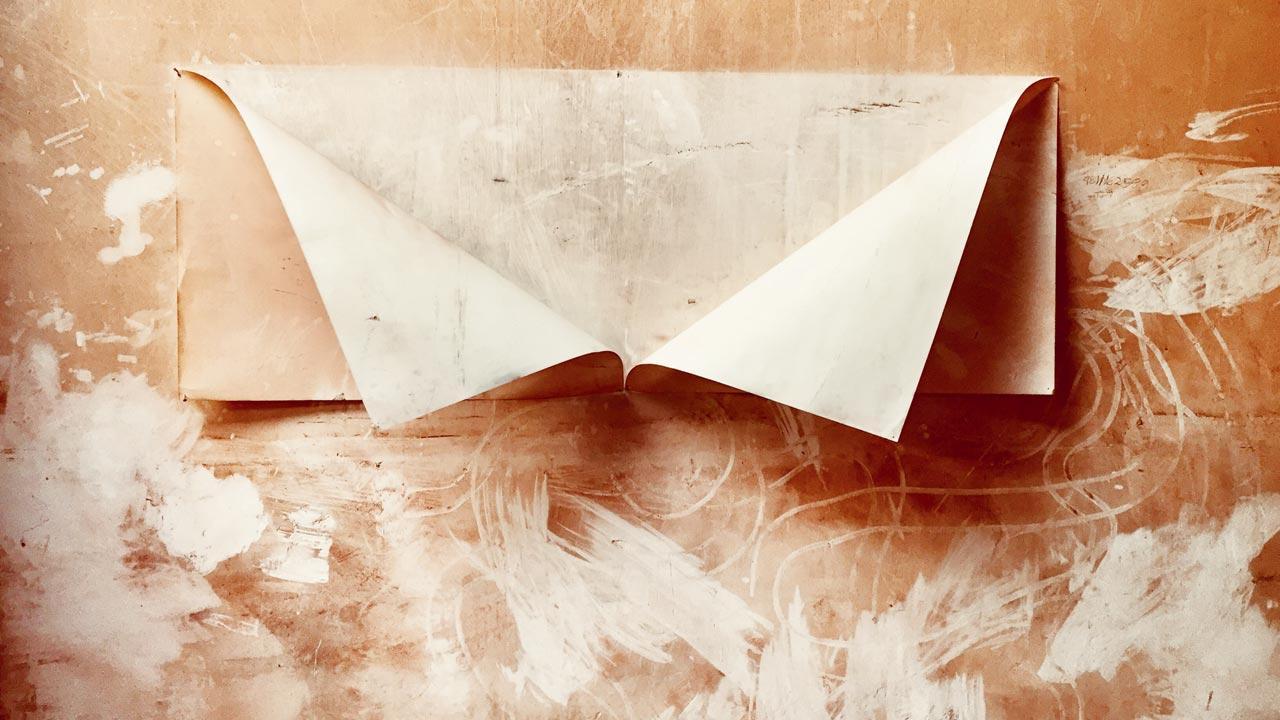In his new exhibition, visual artist M Pravat tries to catch dust, which never settles, but travels across terrains despite the lockdown

Granular Structures
When artist M Pravat’s 8-foot-tall metal-framed concrete panels arrived at Pune’s Vida Heydari Contemporary in the beginning of March, no one expected his works, Movement in Stillness, to reside there for three months. But, the exhibition has now been extended till May end, owing to the lockdown.
The twin works, made of fired bricks, have created quite a sensation in the gallery’s Koregaon Park neighbourhood. Bystanders gathered to see the 25 off-loaders lugging the 1,000 kg frames. Visual art practitioners and patrons in other cities also became privy to the moment, after a hoisting video floated in the online space. The cut-marked bricks have reminded viewers of the basic raw material in our surrounding environment.
Celestial Bodies
While the gigantic frames resemble an excavation site from an aerial angle, they also evoke associations with a brick-laying Lego. As Mumbai-based curator Jesal Thacker puts it, Pravat’s bricks are not just awe-evoking building material, but they are open-to-interpretation poetic devices.
“The artist sees disorder in the cities and townships; he senses the dust rising from a hectic construction spree. But, he doesn’t just showcase the disorder, Pravat
[also] creates a semblance of an order by juxtaposing materials and narratives.”
Terrestrial Bodies
Bricks, essential to Pravat’s practice since he post-graduated from MS University Baroda in 2005, gel well with other elements used in the 35-odd works accompanying Movement in Stillness, which are part of the exhibition in Pune titled, Fugitive Dust. Curator Sabih Ahmed, who lives in Dubai, deserves special kudos for seizing the essence of Pravat’s oeuvre in a powerful construct of the fleeting transitory and yet omnipresent dust.
Dust equates all urbanscapes—be it the dust in Pune’s newest art gallery that follows social distancing norms, the artist’s studio shed in South Delhi’s Rajpur Khurd, or this columnist’s Mahim residence, where new housing towers and renovation projects add a seen-unseen coat, found on laptop screens, book shelves, photo frames, you name it.
Entropy
Fugitive Dust showcases the dust-laden ecosystem that we have jointly created and which we collectively complain about. Pravat uses cut slate, wood, paper, cement, granite, pigment along with marked bricks, to create sculptural installations, paintings, drawings, collage works and prints. For instance, the Entropy, and Celestial/Terrestrial Bodies series—mixed media on Hahnemuhle Acid-free paper—point towards unrecognisable annotations and smudged records, symbolic of the changing metamorphised cities and suburbs of India. The circular forms contain a zig zag slippery path to reality. Pravat’s thoughts on urban expansion find expression in Settlement and Perforated Earth or Granular Structures. “Not just Delhi, but most cities seem to stretch its metropolitan borders, eating into the adjacent grasslands, salt pans and forest reserves. The unauthorised structures are also worrying; I see so many of them when I walk through the bylanes in the Chhatarpur vicinity, where I have been living for a while now.”
Pravat feels the new cities form a unique morphology of elements that encompass colonial city plans, pre-modern architecture and temporary settlements and slums, which aid new townships. His earlier exhibitions—in metros like Dubai, New York, Delhi, Mumbai and Seoul—capture the fluidity and movement in built environments. For example, in the 2008 show at Art Musings, Colaba, he concentrated on lavish interiors. Titled Late Again, the plush upholstered super-furnished spaces, etched with oil on canvas, trigger thoughts on the absent humans. The Diagram of Unformed Desires series, seen in Pune, as well as Dubai, are diptychs with a distinct materiality. Similarly, his New York exhibition From Today, I Have No Future wore the trappings of architectural maps sans its measurement math.
M Pravat’s wall installations, Movement in Stillness, is part of Fugitive Dust at Vida Heydari Contemporary, Pune. The exhibition showcases the dust-laden ecosystem we have jointly created and which we collectively complain about
His tryst with materials, specifically dust, started in a crowded urban Kolkata. As a self-taught artist, a reluctant graduate, he internalised the cacophony of potato sellers competing with screeching buses in Salt Lake and Fulbagan. Later, when he moved to Baroda as a Fine Arts student, noise and dust took a backseat. Learning and unlearning followed at a slower pace. He met artists and faculty from all over India; later one fellow student, a sculptor named Vinima Gulati, hailing from Chandigarh, became his life partner. Post 2006, both chose to settle down in a suburb of South Delhi, a city characterised by dust storms in the summer, which their school going daughter has also accepted. Pravat’s studio setting resembles a mason’s warehouse, thriving on abundant stacks of nails, cement, slate and of course bricks, and a team of carpenters, who assist the creative process.
Pravat says dust is memory, because it holds the past. Interestingly, his theory is echoed by a bilingual online literary journal named Hakara, which has called for contributions on the role of “dust” in shaping human understanding of history and culture? Is dust a mere witness to the transformation process around us, ask the editors. They have also asked a power-related equation—is the weaker section of society treated as dust by the dominant side? Answers are awaited.
More than the exhibition, the conversation around dust has popularised Pravat’s trajectory. It has invited varied viewers, in which one is particularly quotable. Ghashiram Kotwal fame actor-psychiatrist Dr Mohan Agashe feels Fugitive Dust seems just unexplained materials if viewed without the context. But if seen through the prism of the changes in our neighbourhood, there is so much to dust.
Sumedha Raikar-Mhatre is a culture columnist in search of the sub-text. You can reach her at sumedha.raikar@mid-day.com
 Subscribe today by clicking the link and stay updated with the latest news!" Click here!
Subscribe today by clicking the link and stay updated with the latest news!" Click here!









